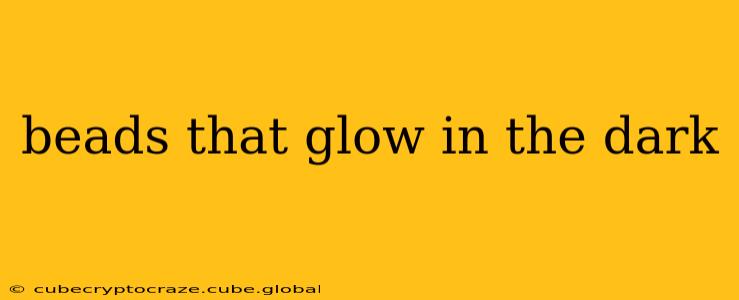Glow-in-the-dark beads are a captivating crafting material, offering endless possibilities for creative projects. From jewelry making and party decorations to science experiments and even practical applications, these luminous beads add a unique touch to any endeavor. This guide delves into the science behind their glow, explores different types available, and provides inspiration for their use.
How Do Glow-in-the-Dark Beads Work?
Glow-in-the-dark beads achieve their luminous effect through phosphorescence. Unlike fluorescence, which requires a continuous light source, phosphorescent materials absorb energy (usually from sunlight or UV light) and then slowly release it as light over a period of time. The longer the beads are exposed to a light source, the brighter and longer they will glow. The specific materials used in the beads determine the intensity and duration of their glow. Common materials include various types of phosphors, often incorporating elements like zinc sulfide or strontium aluminate.
What Types of Glow-in-the-Dark Beads Are Available?
The market offers a diverse range of glow-in-the-dark beads, varying in:
- Size and Shape: From tiny seed beads to larger, chunky beads, and from round to square, star-shaped, and more. The size and shape impact both their aesthetic appeal and suitability for specific projects.
- Color: While the most common is a pale green or blue glow, some beads are designed to emit different colors. The color is determined by the specific phosphor used in the bead's composition.
- Material: Besides the phosphorescent material, the beads themselves can be made from plastic, glass, or even resin. The material affects durability, transparency, and the overall look of the finished product.
- Intensity and Duration of Glow: The brightness and length of the glow depend on several factors, including the type of phosphor, the duration of charging, and the age of the beads. Some beads offer a brighter, shorter glow, while others offer a fainter but longer-lasting luminescence.
What Are Glow-in-the-Dark Beads Used For?
The applications of glow-in-the-dark beads are truly extensive:
- Jewelry Making: Creating necklaces, bracelets, earrings, and keychains with a unique, nighttime sparkle.
- Party Decorations: Enhancing party atmospheres with glowing decorations, centerpieces, and even costumes.
- Science Experiments: Exploring the principles of phosphorescence and light emission in educational settings.
- Home Décor: Adding a touch of magic to rooms with glowing accents or even creating luminous curtains or wall art.
- Safety Features: Used in clothing or accessories to enhance visibility at night.
How Long Do Glow-in-the-Dark Beads Glow?
The duration of a glow-in-the-dark bead's luminescence varies widely depending on several factors. Generally, you can expect anywhere from a few minutes to several hours, depending on the charging time and the type of bead. Newly charged beads will typically glow brighter and longer than older ones whose phosphorescent material has degraded over time. High-quality beads with strontium aluminate phosphors can glow for several hours after a good charge.
Are Glow-in-the-Dark Beads Safe?
Most glow-in-the-dark beads are considered safe for crafting and other uses. However, it's crucial to purchase beads from reputable suppliers to ensure they meet safety standards and are free of harmful chemicals. Always supervise children when they are handling or using glow-in-the-dark beads. Avoid ingestion and ensure proper ventilation if working with large quantities or in enclosed spaces.
Where Can I Buy Glow-in-the-Dark Beads?
Glow-in-the-dark beads are readily available online through various craft supply retailers and online marketplaces. Local craft stores may also carry a selection. When purchasing, always check reviews and ensure the seller has a good reputation for quality products.
Can I Make My Own Glow-in-the-Dark Beads?
While creating glow-in-the-dark beads from scratch requires specialized materials and processes, it’s certainly possible. It would involve mixing phosphorescent powders with resins or other binding agents and then molding them into bead shapes. This requires experience in resin casting or similar techniques.
This guide provides a comprehensive overview of glow-in-the-dark beads, covering their functionality, types, applications, and safety considerations. With their versatility and captivating luminescence, they offer limitless potential for creativity and innovation.
